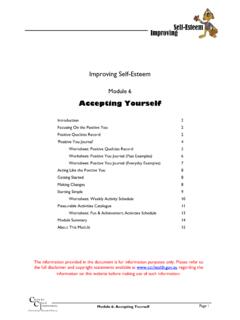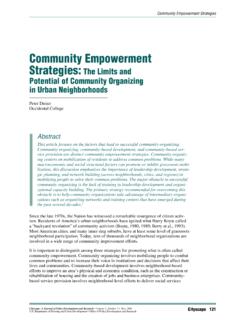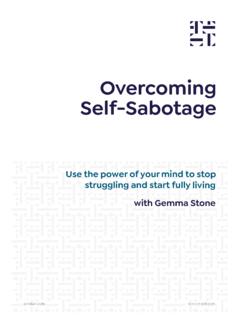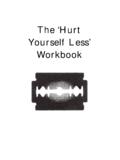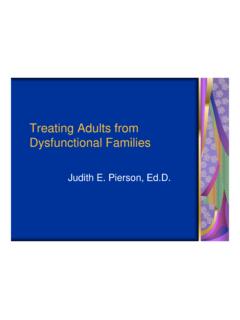Transcription of BingeEating: BreakingtheCycle Aself …
1 BingeEating: BreakingtheCycleAself-helpgu idetowardsrecoveryBingeEating:Breakingth eCycleA self -help guide towards recoveryWith sincere thanksBodywhys is hugely indebted to Janie Loubser, former volunteer,and to all those who shared with us the stories of their struggle with,and recovery from, Binge Eating also wish to thank all those who assisted in the writingand editing of this project was funded byNational Office for Suicide Prevention (NOSP) ThinkBodywhysLtd.(2015)ContentsIntroduct ion11. Binge Eating Disorder3 What is Binge Eating Disorder?3 What causes Binge Eating Disorder?6 Treatment and support102. Making Your DecisionToTake Back Control153. self -help Section17 How to use the self -help section17 Keeping a food diary17 Devising a meal plan22 Skills for developing healthy eating23 Stop dieting264.
2 Coping With Change29 Changing your thought patterns29 Coping with difficult feelings29 Thoughts on body image305. Looking After Yourself33 Looking after your physical health33 Looking after your emotional health35 Dealing with difficulties366. Helpful Resources377. References398. Blank Food Diary41 This is the second edition ofBinge Eating: Breaking the you have used this book either as a source of information or as a recovery tool,we would be very happy to hear your feedback. You can send your feedback toBodywhys, PO Box 105, Blackrock, Co. Dublin, or via every effort has been made to ensure that the information containedin this booklet is accurate, no legal responsibility is accepted by the authors orBodywhys for any errors or Bodywhys The Eating Disorders Association of Ireland, was first established in1995, it provided support primarily to people affected by Anorexia Nervosa and BulimiaNervosa.
3 In recent years, a significant number of the people who have contactedBodywhys have requested information and support in their struggle to overcome bingeeating Disorder or compulsive overeating. Many callers to the Bodywhys helpline, and toour email support service, report having lived with their disorder in isolation for manyyears. They want as much information as possible about how to achieve freedom fromwhat they often experience as an enslavement or addiction to food. Many people arelooking for practical suggestions for regaining control over their behaviours. They feelready to begin to engage with the process of change and want to know where to Eating: Breaking the Cycleis a response to the needs expressed by the peoplewho have accessed our the booklet was initially meant to address the lack of information andpractical guidance available to people with Binge Eating Disorder, many of thestrategies offered in the self -help section of the booklet may also be of great use topeople caught up in the binge-purge cycle that characterises Bulimia Nervosa and thatcan also exist in Anorexia an eating disorder, food is not used to nourish the body.
4 It is used to manageemotional needs. Eating to meet psychological needs in this way is often referred to asemotional eating. Food can be used to comfort, to self soothe, to regulate mood, as ameans of coping with unmanageable feelings. Food can be used to manage emotionaldistress in an effort to feel better. Many people use food in this way, to a degree. Manypeople eat too much at some point in their life. They may restrict their eating as a meansof numbing upsetting feelings, or to distract from an emotional state that they don twant, or feel unable to cope with. Eating is used as a coping mechanism. This becomesproblematic when it becomes a habit, an automatic, or go to behaviour, that turns into acompulsion underpinned by a sense of a loss of from an eating disorder always requires attention to both the physical and thepsychological aspects of the disorder.
5 Treatment programmes with a focus on diet aloneare unlikely to be effective in the long term unless the psychological reasons and theemotional needs that underlie the behaviour are also Box 105, Blackrock, Co. DublinT+353 1 283 Binge Eating DisorderWhat is Binge Eating Disorder?Many people overeat from time to time, and many people often feel they have eatenmore than they should have. Some people, however, feel distressed by their feel out of control and binge on food in order to manage their negative mood orother feelings. There is a powerful craving for food which is experienced as eat what most people would think is an unusually large amount of , researchers, health professionals and clinicians have acknowledged thatbinge eating is a distinct eating disorder, namely Binge Eating Disorder (BED).
6 1, 2, 3, 4, 5 The better known eating disorder, Bulimia Nervosa involves recurrent episodes ofbinge eating followed by compensatory purging through exercise, self -inducedvomiting and/or the use of laxatives. The significant difference between BulimiaNervosa and Binge Eating Disorder is that with BED, there is no immediate attemptto counter the binge through purging, exercise or other with other eating disorders, there are physical and psychological implications forindividuals affected by Binge Eating , 7 Intense levels of suppressing foodrelated thoughts can heighten concerns in relation to weight, eating and eatingpsychopathology, including for some individuals with Eating Disorder has a lifetime prevalence rate of amongst women amongst men and women who binge eat experiencecomparable levels of clinical impairment10and some individuals with BED are alsoaffected by , 12, 13 According to the American Psychiatric Association (APA)
7 ,14 Binge Eating Disorder isdefined as: Recurring episodes of eating significantly more food in a short period of timethan most people would eat under similar circumstances, with episodes markedby feelings of lack of control. Someone with Binge Eating Disorder may eat tooquickly, even when he or she is not hungry. The person may have feelings of guilt,embarrassment, or disgust and may binge eat alone to hide the disorder is associated with marked distress and occurs, on average, at leastonce a week over three months Diagnostic and Statistical Manual of Mental Disorders (DSM) criteriaBinge Eating Disorder: DSM-V15 Binge Eating: Breaking the Cycle2 Introduction(continued) low self - esteem is one of the major risk factors common to all eating disorders and thebuilding of self - esteem is not only crucial in the prevention of eating disorders, but is alsocentral to recovery.
8 A return to health will also involve looking closely at the stressors inour lives and recognising that we can make choices to reduce our capacity for choice is perhaps the greatest indicator of the return to ahealthier self . With adequate support and good levels of motivation, some people willmanage to recover without the help of professionals. Many others will require theassistance of professionals to guide them towards Eating: Breaking the Cycleis a self -help booklet designed both as an informationresource and as a practical tool to help you to acquire greater insight into what you areexperiencing and to empower you to make choices that will facilitate change. It may helpyou to gain a better understanding of how your thoughts, beliefs, feelings and behavioursare interconnected and influence each other.
9 This may provide you with a sense of greatercontrol over your booklet can be used with or without the guidance of a healthcare professional. It doesnot replace the need for medical assessment. It is not designed as an alternative toprofessional support, nor does it offer any quick or easy solutions. Recovery will take timeand with an eating disorder requires a vast amount of emotional, mental and physicalenergy. overcoming an eating disorder will mean learning how to start to channel thisenergy in ways that will enhance, rather than diminish, your capacity to enjoy life to the are now many resources available to people who want to gain a betterunderstanding of eating disorders and how to recover from them. Rather than provide anextensive list of resources, we have included information that will signpost you to helpfulresources on page 37 of the Eating: Breaking the Cycle4 Impact of Binge Eating DisorderAs with other eating disorders, some people may not fit the exact criteria for aformal diagnosis, but they may recognise, in the aforementioned criteria, patterns ofbehaviour and emotional states that correspond to what they are almost always occur in secret and an appearance of normal eating is oftenmaintained in front of others.
10 The food that is eaten is usually filling and high incalories. It tends to be food that people regard as fattening and which they areattempting to exclude from their diet. Often, the food is consumed very quickly. It isseldom tasted or enjoyed and the person is constantly thinking about what to eatnext. While in Binge Eating Disorder there is no purging, namely getting rid of thefood to prevent weight gain, or to attempt to reverse feelings such as a lack ofcontrol, guilt and shame, there may be sporadic fasts or repetitive diets and oftenfeelings of shame or self -hatred surface after a binge. Body weight may vary fromnormal to mild, moderate, or severe person affected by Binge Eating Disorder may find themselves trapped in a cycleof dieting, binging, self -recrimination and self -loathing.
